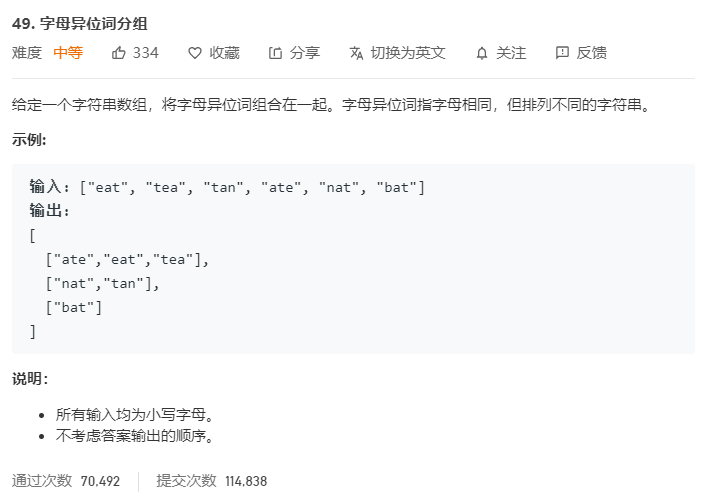[Lc]49字母异位词分组
Contents
题目

题解
1. unordered_map排序法
- 时间复杂度:排序的话算作$O(Klog{K})$,最外层的 for 循环,所以就是 $O(nKlog{K})$。
- 空间复杂度:$O(NK)$,用来存储结果。
用一个unordered_map存排序后的字符串和该字符串所在res的位置,然后挨个将字符串存入相应的位置。
class Solution {
public:
vector<vector<string>> groupAnagrams(vector<string>& strs) {
vector<vector<string>> res;
unordered_map<string, int> m;//key值是字符串排序后的值,value是该字母异位词在res中的位置
for(const auto& str : strs){
auto t = str;//t用来存排序的str
sort(t.begin(), t.end());//将t排序
if(!m.count(t)){//若m中没有这个t
m[t] = res.size();// 在m中赋值新增一维的位置,即res现有长度(因为res从0开始)
res.emplace_back();//则在res中增加一维,用来存这个新t的字母异位词,注意要先给m赋值新位置,否则res.size()会多一位
}
res[m[t]].push_back(str);//然后将该字符串存入res中
}
return res;
}
};
2. unordered_map计数法
- 时间复杂度:$O(NK)$
- 空间复杂度:$O(NK)$,用来存储结果。
class Solution {
public:
vector<vector<string>> groupAnagrams(vector<string>& strs) {
vector<vector<string>> res;
unordered_map<string,int> m;//key值是字符串计数后的字符串,value是该字母异位词在res中的位置
for(auto& str:strs){
vector<int> cha(26);//用cha给26个字母计数
string key_cha;//存最终的转为字符串的计数结果
for(auto& s:str){
cha[s-'a']++;
}//每个字符挨个统计数目
for(auto& c:cha){
key_cha += to_string(c);
}//cha转为字符串
if(!m.count(key_cha)){
m[key_cha] = res.size();
res.emplace_back();
}//这一块和排序法一样
res[m[key_cha]].push_back(str);
}
return res;
}
};
Author ChrisHRZ
LastMod 2020-05-05